七年级英语语法点整理
七年级英语语法知识总结(10篇)
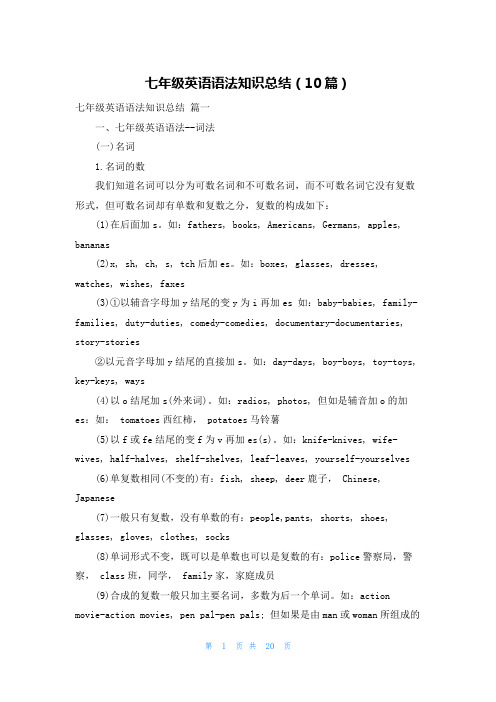
七年级英语语法知识总结(10篇)七年级英语语法知识总结篇一一、七年级英语语法--词法(一)名词1.名词的数我们知道名词可以分为可数名词和不可数名词,而不可数名词它没有复数形式,但可数名词却有单数和复数之分,复数的构成如下:(1)在后面加s。
如:fathers, books, Americans, Germans, apples, bananas(2)x, sh, ch, s, tch后加es。
如:boxes, glasses, dresses, watches, wishes, faxes(3)①以辅音字母加y结尾的变y为i再加es 如:baby-babies, family-families, duty-duties, comedy-comedies, documentary-documentaries, story-stories②以元音字母加y结尾的直接加s。
如:day-days, boy-boys, toy-toys, key-keys, ways(4)以o结尾加s(外来词)。
如:radios, photos, 但如是辅音加o的加es:如: tomatoes西红柿, potatoes马铃薯(5)以f或fe结尾的变f为v再加es(s)。
如:knife-knives, wife-wives, half-halves, shelf-shelves, leaf-leaves, yourself-yourselves (6)单复数相同(不变的)有:fish, sheep, deer鹿子, Chinese, Japanese(7)一般只有复数,没有单数的有:people,pants, shorts, shoes, glasses, gloves, clothes, socks(8)单词形式不变,既可以是单数也可以是复数的有:police警察局,警察, class班,同学, family家,家庭成员(9)合成的复数一般只加主要名词,多数为后一个单词。
七年级全册英语语法大全

We (You, They) are +
……
They are my friends. You are good students. 用法口诀: 我 (I) 用 am, 你 (you) 用 are,is 跟着他 (he),她 (she),它 (it) 。单数名词用
is ,复数名词全用
are。变否定,更容易,
十九、若表达具体数目,要借助数量词 例: pair( 对,双 ); suit( 套 ); a pair of glasses; two pairs of trousers
二十、另外还有一些名词,其复数形式有时可表示特别意思, 例: goods 货物, waters 水域, fishes(各种)鱼
二十一、除人民币元、角、分外,美元、英镑、法郎等都有复数形式。
例: fish → fish; sheep→ sheep; cattle→ cattle; deer→ deer; salmon→ salmon 十二、极少数单词,其复数形式没有任何规律。 读音变化:没有规律。
例: man→ men; woman →women; child →children; person → people; ox → oxen 十三、一些单数词得加 en 才能变成复数词:
形容词性物主代词 (my/your/his/her/its/our/their)+ 名词 而名词性物主代词则相当于形容词性物主代词 +名词 ,故其后不必加名词。如:
Is this your book?
No,, it isn?t, it?s hers(her book) This pen is mine.
1.in; on; at 用在时间词前,表“在”
第四课时 介词知识点
七年级英语语法大全(动词、名词所有格,一般现在时)

七年级英语语法大全(动词、名词所有格,一般现在时)一. 动词be(is,am,are)的用法我(I)用am, 你(you)用are,is跟着他(he)、她(she)、它(it)。
单数名词用is,复数名词全用are。
变否定,更容易,be后not加上去。
变疑问,往前提,句末问号莫丢弃。
还有一条须注意,句首大写莫忘记。
二. 不定冠词a和ana和an都是不定冠词,表示一(个,支,本,块……)的意思,但不强调数量概念,而是强调类别,用来限定名词。
a用在辅音音素开头的单数名词前,如:a pencil(一支铅笔),a book(一本书);an用在元音音素开头的名词前,如an eraser(一块橡皮)。
如果名词前有修饰语,用a还是用an,则以该修饰语的第一音素决定用a还是用an。
如:a clock 一座钟an old clock 一座旧钟a book 一本书an English book 一本英语书a nice apple 一个可爱的苹果an apple 一个苹果三. this,that和it用法(1)this和that是指示代词,it是人称代词。
(2)距离说话人近的人或物用this, 距离说话人远的人或物用that。
如:This is a flower. 这是一朵花。
(近处)That is a tree. 那是一棵树。
(远处)(3)放在一起的两样东西,先说this, 后说that。
如:This is a pen. That is a pencil. 这是一支钢笔。
那是一支铅笔。
(4)向别人介绍某人时说This is…, 不说That is…。
如:This is Helen. Helen, this is Tom. 这是海伦。
海伦,这是汤姆。
(5)This is 不能缩写, 而That is可以缩写。
如:This is a bike. That’s a car. 这是一辆自行车。
那是一辆轿车。
(6)打电话时,介绍自己用this, 询问对方用that。
初一英语语法知识点总结归纳

初一英语语法知识点总结归纳学习是一架保持平衡的天平,一边是付出,一边是收获,少付出少收获,多付出多收获,不劳必定无获!要想取得理想的成果,勤奋至关重要!只有勤奋学习,才能成就奇妙人生!勤奋出天才,这是一面永不褪色的旗帜,它永久激励我们不断追求、不断探究。
有书好好读,有书赶快读,读书的时间不多。
只要我们刻苦拼搏、一心向上,就确定能取得令人满意的成果。
接下来是我为大家整理的初一英语语法学问点〔总结〕归纳,希望大家宠爱!初一英语语法学问点总结归纳一【陈述句】1、概念:说明一个事实或是陈述说话人的看法的〔句子〕,句末用句号。
2、分类:陈述句根据其语法结构,可大体分为―主语+谓语‖和―主语+连系动词+表语‖两种;而从语气的角度分,又可分为确定陈述句和否认陈述句(1)“主语+谓语”结构① 确定陈述句I like that book.我宠爱那本书。
(陈述一个事实)I really agree.我确实同意。
(陈述一个观点)② 否认陈述句I did not buy the TV.我没有买那个电视。
(陈述一个事实)(2)主语+连系动词+表语结构① 确定陈述名The film is boring . 这部电影没意思。
(陈述观点)② 否认陈述句Smoking is not good for your health.抽烟对你的健康没有好处。
(陈述一个事实)3、陈述句的否认结构:陈述句的否认式主要用两种结构来表达:(1)句子的谓语动词为be , have 或者谓语动词有助动词、情态动词时,其否认结构为:主语+谓语动词/助动词/情态动词+ not + 其他成分I am not a teacher. 我不是老师。
We have not (haven`t) any books on animals. 我们没有任何有关动物方面的书。
The children are not (aren`t) playing in the playground. 孩子们没在操场上玩。
最全七年级英语语法知识点汇总

最全七年级英语语法知识点汇总英语语法虽然是从简单的一些日常用语出发的,但语法中常会有一些知识点看起来很细小,容易被忽视,但这些知识点掌握不熟练,往往会造成一些语法应用上的错误。
接下来是为大家整理的最全(七班级英语)语法知识点汇总,希望大家喜欢!最全七班级英语语法知识点汇总一1.陈述句肯定陈述句a)Thisisabook.(be动词)b)Helooksveryyoung.(连系动词)c)Iwantasweatlikethis.(实义动词)d)Icanbringsomethingstoschool.(情态动词)e)There’sacomputeronmydesk.(Therebe结构)否定陈述句a)Thesearen’ttheirbooks.b)Theydon’tlooknice.c)Katedoesn’tgotoNo.4MiddleSchool.d)Katecan’tfindherdoll.e)Thereisn’tacathere.(=There’snocathere.)2.祈使句肯定祈使句a)Pleasegoandasktheman.b)Let’slearnEnglish!c)Comein,please.否定祈使句a)Don’tbelate.b)Don’thurry.3.疑问句1)一般疑问句a)IsJimastudent?b)CanIhelpyou?c)Doesshelikesalad?d)DotheywatchTV?e)Isshereading?肯定回答:a)Yes,heis.b)Yes,youcan.c)Yes,shedoes.d)Yes,theydo.e)Yes,sheis.否定回答:a)No,heisn’t.b)No,youcan’t.c)No,shedoesn’t.d)No,theydon’t.e)No,shei sn’t.2)选择疑问句Isthetablebigorsmall?回答It’sbig./It’ssmall.3)特殊疑问句①问年龄HowoldisLucy?Sheistwelve.②问种类Whatkindofmoviesdoyoulike?Ilikeactionmoviesandcomedies.③问身体状况Howisyouruncle?Heiswell/fine.④问方式Howdo/canyouspellit?L-doubleO-K.Howdowecontactyou?Mye-*******************************.⑤问原因Whydoyouwanttojointheclub?⑥问时间What’sthetime?(=Whattimeisit?)It’saquartertotena.m..Whattimedoyouusuallygetup,Rick?Atfiveo’clock.Whendoyouwanttogo?Let’sgoat7:00.⑦问地方Where’smybackpack?It’sunderthetable.⑧问颜色Whatcolorarethey?Theyarelightblue.What’syourfavouritecolor?It’sblack.⑨问人物Who’sthat?It’smysister.Whoistheboyinblue?Mybrother.Whoisn’tatschool?PeterandEmma.WhoareLisaandTimtalkingto?⑩问东西What’sthis/that(inEnglish)?It’sapencilcase.Whatelsecanyouseeinthepicture?Icanseesomebroccoli,strawberriesandh amburgers.11问姓名What’syouraunt’sname?HernameisHelen./She’sHelen.What’syourfirstname?Myfirstname’sBen.What’syourfamilyname?Myfamilyname’sSmith.12问哪一个Whichdoyoulike?Ilikeoneinthebox.13问字母Whatletterisit?It’sbigD/smallf.14问价格Howmucharethesepants?They’re15dollars.15问电话号码What’syourphonenumber?It’s576-8349.16问谓语(动作)What’shedoing?He’swatchingTV.17问职业(身份)Whatdoyoudo?I’mateacher.What’syourfather?He’sadoctor.最全七班级英语语法知识点汇总二首先要介绍的就是关于动词be(is,am,are)的用法,动词在一个(句子)中很重要,对于英语来说be(is,am,are)更是常常用到,学会be 的用法就是学好英语的根基。
七年级上册,英语,所有的语法

七年级上册,英语,所有的语法
以下是七年级上册英语的部分语法知识点:
1. 名词:名词是表示人、事物、地点等名称的词。
2. 形容词:形容词用来描述名词的性质、特征或状态。
形容词可以放在名词前面或后面。
3. be动词:be动词包括am, is, are三种形式,用来表示主语的状态或特征。
4. 助动词:助动词包括do, does, did三种形式,用来帮助主要动词表达时态、语态、否定等意义。
5. 介词:介词用来表示名词与其他词语之间的关系,如in, on, under等。
6. 连词:连词用来连接两个句子或从句,如and, but, or等。
7. 代词:代词是用来代替名词的词,如I, you, he等。
8. 副词:副词用来修饰动词、形容词或其他副词,表示程度、方式、时间等意义。
9. 动词:动词是表示动作或状态的词,如run, jump, like等。
10. 冠词:冠词用来限定名词,包括定冠词the和不定冠词a/an两种形式。
以上只是部分语法知识点,想要掌握更多语法知识,可以查阅教材或请教英语老师。
七年级英语语法知识点总结
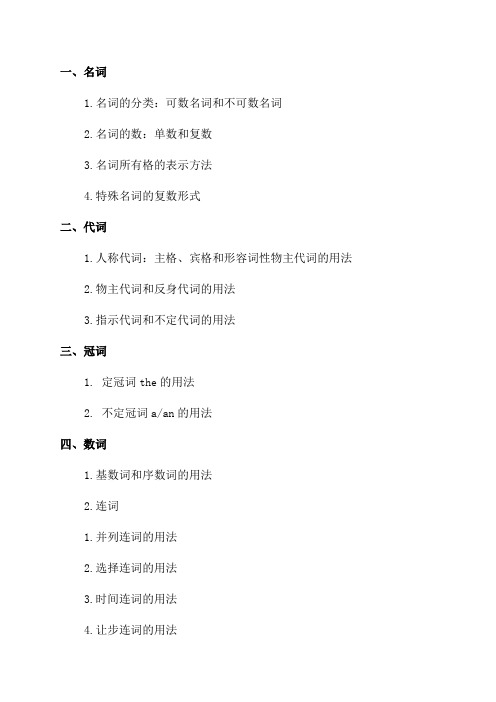
一、名词1.名词的分类:可数名词和不可数名词2.名词的数:单数和复数3.名词所有格的表示方法4.特殊名词的复数形式二、代词1.人称代词:主格、宾格和形容词性物主代词的用法2.物主代词和反身代词的用法3.指示代词和不定代词的用法三、冠词1. 定冠词the的用法2. 不定冠词a/an的用法四、数词1.基数词和序数词的用法2.连词1.并列连词的用法2.选择连词的用法3.时间连词的用法4.让步连词的用法5.结果连词的用法五、形容词和副词1.形容词的用法和比较级、最高级的构成2.副词的用法和比较级、最高级的构成六、时间状语从句1.引导时间状语从句的连词的用法2.时间状语从句的时态和语序七、地点状语从句1.引导地点状语从句的连词的用法八、因果状语从句1.引导因果状语从句的连词的用法九、条件状语从句1.引导条件状语从句的连词的用法2.条件状语从句的时态和语序十、目的状语从句1.引导目的状语从句的连词的用法十一、同位语从句1.同位语从句的引导词十二、定语从句1.引导定语从句的关系代词和关系副词的用法十三、省略句1.句子中的省略现象十四、被动语态1.被动语态的构成和用法十五、宾语从句1.引导宾语从句的连词的用法十六、反意疑问句1.反意疑问句的构成和用法十七、动词时态和语态1.一般现在时、一般过去时和一般将来时的构成和用法2.现在进行时和过去进行时的构成和用法3.现在完成时和过去完成时的构成和用法4.一般将来时和一般过去将来时的构成和用法。
七年级英语语法知识点已整理

精品文档七年级英语语法知识点总结复习课时一教学任务一、 重点语法1. 动词be (am,is,are )的用法:be 动词包括“am”, “is”, “are”三种形式。
①第一人称单数(I)配合am 来用。
句型解析析:I am+… 例句:I am Snoopy.I am ten years old. I am a student. I am a boy.②第二人称(You)配合are 使用。
句型解析:You are+… 例句:You are my good friend.You are a good teacher. You are beautiful ③第三人称单数(He or She or It)配合is 使用。
句型解析:She(He, It) is +…… 例句:She is a good girl.She is so tall. She is short.④人称复数 (we /you/they)配合are 使用。
句型解析:We (You, They) are +…… 例句 We are in Class 5,Grade 7.They are my friends. You are good students.用法口诀:我(I)用am, 你(you)用are ,is 跟着他(he),她(she),它(it)。
单数名词用is ,复数名词全用are 。
变否定,更容易,be 后not 加上去。
变疑问,往前提,句末问号莫丢弃。
还有一条须注意,句首大写莫忘记。
对应练习:一. 用括号中适当的词填空。
1. I ________(am, are, is) from Australia.2. She _______ (am, are, is) a student.3. Jane and Tom _________(am, is, are) my friends.4. My parents ____ (am, is, are) very busy every day.5. _______ (Are, Is, Do, Does) there a Chinese school in New York?6. _______ (Be, Are, Were, Was) they excited when he heard the news?7. There _____ (be) some glasses on it.8. If he _____ (be) free tomorrow, he will go with us. 一、用be 动词的适当形式填空1. I ______ a boy. ______ you a boy? No, I _____ not.2. The girl______ Jack's sister.3. The dog _______ tall and fat.4. The man with big eyes _______ a teacher.5. ______ your brother in the classroom?6. Where _____ your mother? She ______ at home.7. How _______ your father?8. Mike and Liu Tao ______ at school. 9. Whose dress ______ this? 10. Whose socks ______ they? 11. That ______ my red skirt. 12. Who ______ I?13.The jeans ______ on the desk. 14.Here ______ a scarf for you.15. Here ______ some sweaters for you. 16. The black gloves ______ for Su Yang. 17. This pair of gloves ______ for Yang Ling. 18. The two cups of milk _____ for me. 19. Some tea ______ in the glass.20. Gao shan's shirt _______ over there.第二课时(1)英语人称代词和物主代词一、人称代词表示“我”、“你”、“他”、“她”、“它”、“我们”、“你们”、“他们”的词,叫做人称代词。
七年级英语语法归纳
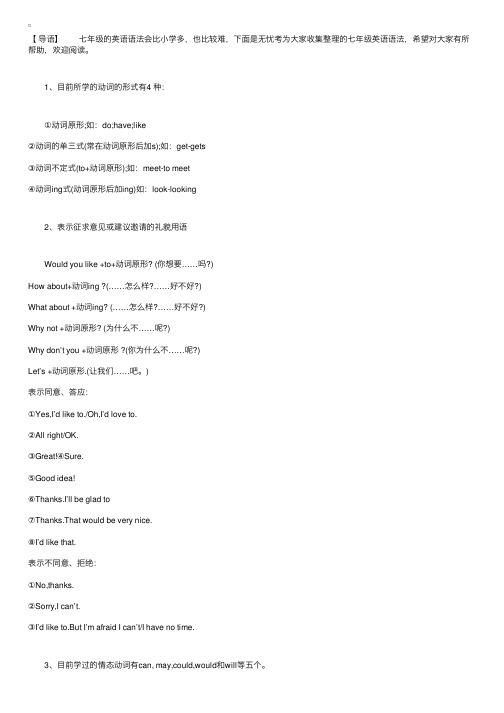
【导语】 七年级的英语语法会⽐⼩学多,也⽐较难,下⾯是⽆忧考为⼤家收集整理的七年级英语语法,希望对⼤家有所帮助,欢迎阅读。
1、⽬前所学的动词的形式有4 种: ①动词原形;如:do;have;like②动词的单三式(常在动词原形后加s);如:get-gets③动词不定式(to+动词原形);如:meet-to meet④动词ing式(动词原形后加ing)如:look-looking 2、表⽰征求意见或建议邀请的礼貌⽤语 Would you like +to+动词原形? (你想要……吗?)How about+动词ing ?(……怎么样?……好不好?)What about +动词ing? (……怎么样?……好不好?)Why not +动词原形? (为什么不……呢?)Why don’t you +动词原形 ?(你为什么不……呢?)Let’s +动词原形.(让我们……吧。
)表⽰同意、答应:①Yes,I’d like to./Oh,I’d love to.②All right/OK.③Great!④Sure.⑤Good idea!⑥Thanks.I’ll be glad to⑦Thanks.That would be very nice.⑧I’d like that.表⽰不同意、拒绝:①No,thanks.②Sorry,I can’t.③I’d like to.But I’m afraid I can’t/I have no time. 3、⽬前学过的情态动词有can, may,could,would和will等五个。
学好情态动词必须把握三个⽤法:①后必须跟动词原形 ;②没有三单式(其后不能加s);③可以把情态动词提到句⾸构成疑问句;可以在情态动词后⾯加上not构成否定句。
4、⽬前学过的后跟动词不定式(to+动词原形)的有: ①would like to+动词原形(想要做某事);want to+动词原形(想要做某事);②forget to+动词原形(忘记要做某事);③like to +动词原形(喜欢做某事);love to +动词原形(喜欢做某事)④ask sb. to +动词原形.(请/叫某⼈做某事)tell sb. to +动词原形.(告诉/叫某⼈做某事)would like sb. to +动词原形.(想叫某⼈做某事)want sb. to +动词原形.(想叫某⼈做某事)⑤have to +动词原形(必须/不得不做某事)⑥Nice/Glad/happy to +动词原形(很⾼兴做某事)如:Nice to meet you.I’m glad to be here. 5、⽬前学过的后跟动词原形的有: ①情态动词:can,may,could,would,will后;②助动词do,don’t,does,doesn’t后(does,doesn’t⼀出现,三单式要滚蛋); ③动词please(请)后:如:Please tell him about the picnic.④短语Why not…/Why don’t you…后;⑤动词let 后;如:Let Jane help you. Let’s go home.⑥动词help后,也可带to;如:Let’s help Maria (to) carry water.⑦祈使句以动词原形开头,如:Have a seat , please.请坐下。
初一英语英语语法总结(共51张)
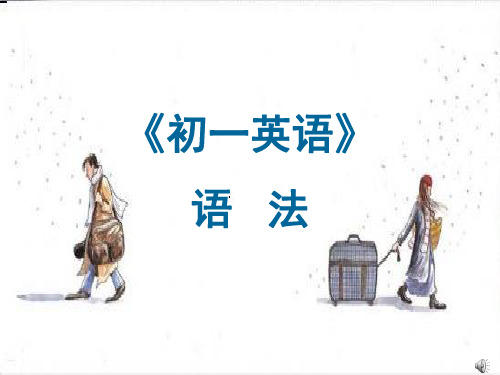
German.
双重所有格
所有’s格结的构形也式可以用于 “of”结构之后,如: a friend of
does
did
done doing
have learn
has learns
had
had having
learned /learnt
learned /learnt
learning
第三人称单数现在式
情况 变化规则
例词
一般情况
结尾为 s,x,sh,ch,o 结尾为辅音
字母+y
+s
+es 变y为 i+es
Be动词
am, is, are was, were
been
is 1.He ________ very good at English.
Practise
Were are 2.My father and I ________ going to Beijing next month.
was 3.________ you on duty the day before yesterday?
2. 在某些度量表示法中:
We have PE lessons three times a week.
3. 用在单数的表语名词前,以表示职业、行 业、宗教、等级等。
George wants to be an engineer.
4. 在以what引导的感叹句中,单数的可数名 词前。
人教版2024七年级英语

人教版2024七年级英语一、单词部分。
1. 单词表整理。
- 按照单元顺序列出每个单元的重点单词,包括单词的拼写、词性、中文释义。
例如:- Unit 1.- name [neɪm] n. 名字;名称。
- nice [naɪs] adj. 令人愉快的;宜人的。
- 对于一些多义词,可以列出不同词性下的主要释义。
2. 单词记忆方法。
- 介绍一些有效的单词记忆技巧,如:- 联想法:例如“pest(害虫)”,可以联想成“拍死它”。
- 词根词缀法:像“un - ”这个前缀表示否定,“happy(高兴的)”加上“un - ”变成“unhappy(不高兴的)”。
二、语法部分。
1. 语法点总结。
- 七年级英语常见语法点,如:- 一般现在时。
- 概念:表示经常或习惯性的动作或状态。
- 结构:主语+动词原形(第三人称单数形式要加 - s或 - es)。
例如:I like apples. He likes apples.- 名词的单复数。
- 规则变化:一般在名词后加 - s,以s、x、ch、sh结尾的加 - es等。
例如:book - books,box - boxes。
- 形容词性物主代词:my(我的)、your(你的/你们的)、his(他的)、her (她的)、its(它的)、our(我们的)、their(他们的)。
2. 语法练习。
- 针对每个语法点编写一些练习题,如:- 用所给动词的适当形式填空。
- She often____(go) to school by bike.- 写出下列名词的复数形式。
- cat____三、课文部分。
1. 课文重点句子整理。
- 从每个单元的课文中挑选出重点句子,如:- 课文中的对话常用句:“What's your name?”“My name is Tom.”- 描述性的重点句子:“There is a big library in our school.”2. 课文理解与背诵。
七年级英语语法知识总结(精选6篇)
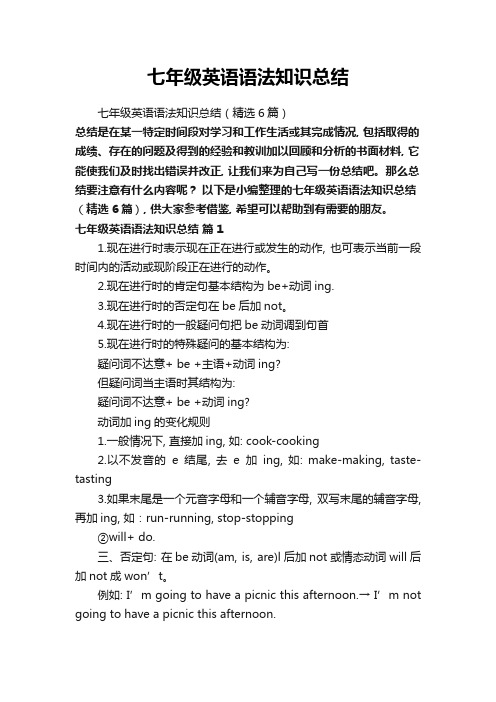
七年级英语语法知识总结七年级英语语法知识总结(精选6篇)总结是在某一特定时间段对学习和工作生活或其完成情况, 包括取得的成绩、存在的问题及得到的经验和教训加以回顾和分析的书面材料, 它能使我们及时找出错误并改正, 让我们来为自己写一份总结吧。
那么总结要注意有什么内容呢?以下是小编整理的七年级英语语法知识总结(精选6篇), 供大家参考借鉴, 希望可以帮助到有需要的朋友。
七年级英语语法知识总结篇11.现在进行时表示现在正在进行或发生的动作, 也可表示当前一段时间内的活动或现阶段正在进行的动作。
2.现在进行时的肯定句基本结构为be+动词ing.3.现在进行时的否定句在be后加not。
4.现在进行时的一般疑问句把be动词调到句首5.现在进行时的特殊疑问的基本结构为:疑问词不达意+ be +主语+动词ing?但疑问词当主语时其结构为:疑问词不达意+ be +动词ing?动词加ing的变化规则1.一般情况下, 直接加ing, 如: cook-cooking2.以不发音的e结尾, 去e加ing, 如: make-making, taste- tasting3.如果末尾是一个元音字母和一个辅音字母, 双写末尾的辅音字母, 再加ing, 如:run-running, stop-stopping②will+ do.三、否定句: 在be动词(am, is, are)l后加not或情态动词will后加not成won’t。
例如: I’m going to have a picnic this afternoon.→ I’m not going to have a picnic this afternoon.四、一般疑问句: be或will提到句首, some改为any, and改为or, 第一二人称互换。
例如: We are going to go on an outing this weekend.→ Are you going to go on an outing this weekend?五、对划线部分提问。
七年级英语语法知识点归纳整理

七年级英语语法知识点归纳整理对初中学生的指导更多的应侧重于学习方法和学习意志品质的培养进入初中以后,学生在学习上的独立性逐步增强。
课堂教学中,教师比较注意启发学生独立思考问题;课堂教学外,学生更多的需要自觉地独立安排自己的学习活动。
接下来是小编为大家整理的七年级英语语法知识点归纳整理,希望大家喜欢!七年级英语语法知识点归纳整理一【重点句子】1.How many colours do you see? 你能看见多少种颜色?how many+可数名词复数, 含有how many的特殊疑问句,要用数词来回答。
如:—How many markers do you have? 你有多少枝水彩笔? —I have ten. 我有十枝。
/----Just one. 只有一个。
2. My skirt is very old. Can I get a new one? 我的裙子很旧了,我能买一条新的吗?one在这里是代词,代替前面的skirt.英语中,为了避免重复,常用one代替上文中已出现过的同一类人或物。
Eg: I have a nice sweater. Do you want one? 我有一件漂亮的毛衣。
你想要一件吗?3. What’s your favourite colour? 你最喜欢的颜色是什么?What’s your favourite…?是询问“你最喜欢的??是什么?”的交际用语,其答语是:My favourite ....is…如:---What are your favourite clothes? 你最喜欢的衣服是什么?---My favourite clothes are blouse and skirts. 我最喜欢的衣服是衬衫和连衣裙。
—What’s your favourite sport? 你最喜欢的运动是什么?—My favourite sport is Ping-pong. 我最喜欢的运动是乒乓球。
七年级英语语法归纳

一、七年级英语语法归纳(一)be动词。
1、be动词概说。
(包括am, are, is)be ①连系动词,本身有词义“是”,在句子中和其后的表语一起构成谓语。
e.g. I am tall.(表语)②助动词,无词义。
e.g. He is playing football.2、be动词的用法。
am →主语是单数第一人称(即I)。
e.g. I am…be are →单数第二人称及所有复数。
e.g. You are…The coats are…is →单数第三人称及不可数名词。
e.g. Your father is…The money is…3、否定句式(即改否定句):在be动词之后+not, 句子其它部位不变。
e.g. He is not a teacher.4、缩写形式。
①主语+be,缩写be第一个字母为’,再与主语合并。
e.g. you are →you’re Jack is →Jack’s②be+not否定形式的缩写,缩写not中“o”为’, 再与be合并。
e.g. is not→isn’t are not→aren’t③不能缩写的情况:this is, these are, those are, am not及缩略的肯定回答。
e.g. Yes, I am. (I’m误)5、含be动词句子的疑问句型转换。
①一般疑问句:将be动词提前,其它照抄不变,最后+?,读升调。
(一般第一人称改为第二人称)e.g. The man in the car is her father. →Is the man in the car her father?I’m a middle school student. →Are you a middle school student?②一般疑问句的肯否定回答。
肯定回答:Yes, 主语+be. 否定回答:No, 主语+be+not.e.g. Is he old? Are you a new student? Is your father at home?Yes, he is. Yes, I am. Yes, he is.No, he is not.(isn’t)No, I’m not.No, he is not.(isn’t)注意:①主语必须用代词回答;②肯定回答不能缩写;③回答第二人称,用第一人称回答。
初一英语语法知识点

初一英语语法知识点对于初一的学生来说,英语语法是学习英语的重要组成部分。
掌握好语法知识,能够帮助我们更准确、更流畅地表达自己的意思。
接下来,让我们一起了解一下初一英语中的一些重要语法知识点。
一、名词名词是表示人、事物、地点或抽象概念的名称的词。
1、名词的分类可数名词:可以用数目来计算的名词,有单数和复数形式。
例如:book(书,单数),books(书,复数)。
不可数名词:不能用数目来计算的名词,一般没有复数形式。
例如:water(水),milk(牛奶)。
2、名词的数可数名词的复数形式变化规则:一般情况下,在词尾加 s,如:desk desks。
以 s,x,ch,sh 结尾的名词,在词尾加 es,如:box boxes,watch watches。
以“辅音字母+y”结尾的名词,把 y 变为 i,再加 es,如:city cities。
以 f 或 fe 结尾的名词,把 f 或 fe 变为 v,再加 es,如:knife knives。
不可数名词的量化:可以用 some,any,much,a little,a lot of 等词来修饰。
二、代词代词是用来代替名词或名词短语的词。
1、人称代词主格:I,you,he,she,it,we,they宾格:me,you,him,her,it,us,them主格在句子中作主语,宾格在句子中作宾语。
例如:I like English (I 作主语)He gives me a book (me 作宾语)2、物主代词形容词性物主代词:my,your,his,her,its,our,their名词性物主代词:mine,yours,his,hers,its,ours,theirs形容词性物主代词后面要接名词,名词性物主代词相当于“形容词性物主代词+名词”。
例如:This is my book (my 后接名词)This book is mine (mine 相当于 my book)3、指示代词this(这个),that(那个),these(这些),those(那些)this 和 that 后跟单数名词,these 和 those 后跟复数名词。
七年级英语全册所有语法知识点
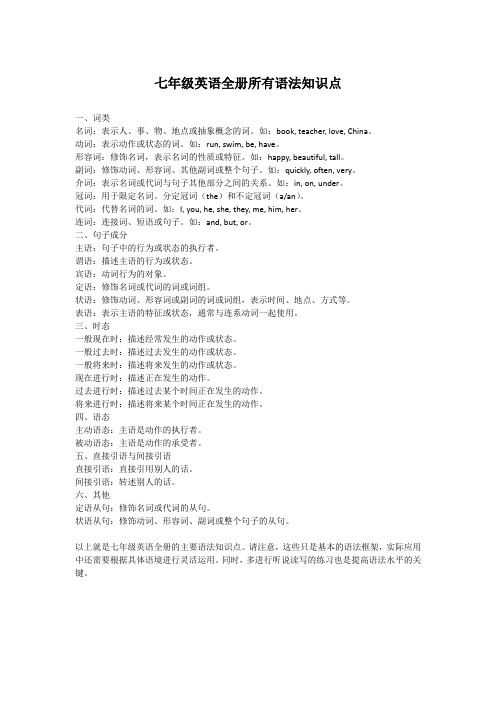
七年级英语全册所有语法知识点一、词类名词:表示人、事、物、地点或抽象概念的词。
如:book, teacher, love, China。
动词:表示动作或状态的词。
如:run, swim, be, have。
形容词:修饰名词,表示名词的性质或特征。
如:happy, beautiful, tall。
副词:修饰动词、形容词、其他副词或整个句子。
如:quickly, often, very。
介词:表示名词或代词与句子其他部分之间的关系。
如:in, on, under。
冠词:用于限定名词。
分定冠词(the)和不定冠词(a/an)。
代词:代替名词的词。
如:I, you, he, she, they, me, him, her。
连词:连接词、短语或句子。
如:and, but, or。
二、句子成分主语:句子中的行为或状态的执行者。
谓语:描述主语的行为或状态。
宾语:动词行为的对象。
定语:修饰名词或代词的词或词组。
状语:修饰动词、形容词或副词的词或词组,表示时间、地点、方式等。
表语:表示主语的特征或状态,通常与连系动词一起使用。
三、时态一般现在时:描述经常发生的动作或状态。
一般过去时:描述过去发生的动作或状态。
一般将来时:描述将来发生的动作或状态。
现在进行时:描述正在发生的动作。
过去进行时:描述过去某个时间正在发生的动作。
将来进行时:描述将来某个时间正在发生的动作。
四、语态主动语态:主语是动作的执行者。
被动语态:主语是动作的承受者。
五、直接引语与间接引语直接引语:直接引用别人的话。
间接引语:转述别人的话。
六、其他定语从句:修饰名词或代词的从句。
状语从句:修饰动词、形容词、副词或整个句子的从句。
以上就是七年级英语全册的主要语法知识点。
请注意,这些只是基本的语法框架,实际应用中还需要根据具体语境进行灵活运用。
同时,多进行听说读写的练习也是提高语法水平的关键。
七年级英语语法大全

七年级英语语法大全【一般现在时】.概念:经常、反复发生的动作或行为及现在的某种状况。
动词用原形(单三人称动词加s / es)(问句和否定句借用助词do / does)【一般过去时】概念:过去某个时间里发生的动作或状态;过去习惯性、经常性的动作、行为。
动词用过去式(问句和否定句借用助词did)【现在进行时】概念:表示现阶段或说话时正在进行的动作及行为。
am +动词-ingis +动词-ingare +动词-ing【过去进行时】概念:表示过去某段时间或某一时刻正在发生或进行的行为或动作。
was +动词-ingwere +动词-ing【一般将来时】概念:以过去某个时间为标准,在此以前发生的动作或行为,或在过去某动作之前完成的行为,即“过去的过去”。
(1)will + 动词原形(2)am +going to+动词原形Is +going to+动词原形are +going to+动词原形【过去将来时】概念:立足于过去某一时刻,从过去看将来,常用于宾语从句中。
(1)would + 动词原形(2)was +going to+动词原形were +going to+动词原形【现在完成时】概念:过去发生或已经完成的动作对现在造成的影响或结果,或从过去已经开始,持续到现在的动作或状态。
have +过去分词has +过去分词【过去完成时】概念:以过去某个时间为标准,在此以前发生的动作或行为,或在过去某动作之前完成的行为,即“过去的过去”。
had +过去分词1. 不定式定义:由to+动词原形构成。
不定式是一种非限定性动词。
而非限定动词是指那些在句中不能单独充当谓语的动词,可分为不定式,动名词,现在分词和过去分词。
2.用途:在句中不能作谓语。
它具有动词的性质,本身可以带宾语和状语。
【动词不定式】1.定义:动词 + 不定式2.用途:动词不定式在句中可以作句子任何成分。
动词不定式的被动形式除了一般形式外还有其完成式和进行式。
[编辑本段][动词不定式的时态、语态]动词不定式可以作以上各种成分,但它毕竟是动词,所以有动词的属性动词不定式及其短语还可以有自己的宾语、状语,虽然动词不定式在语法上没有表面上的直接主语,但它表达的意义是动作,这一动作一定由使动者发出。
七年级英语必考12大语法点,全

七年级英语必考12大语法点,全一. 动词be(is,am,are)的用法我(I)用am, 你(you)用are,is跟着他(he)、她(she)、它(it)。
单数名词用is,复数名词全用are。
变否定,更容易,be后not加上去。
变疑问,往前提,句末问号莫丢弃。
还有一条须注意,句首大写莫忘记。
二. this,that和it用法(1)this和that是指示代词,it是人称代词。
(2)距离说话人近的人或物用this, 距离说话人远的人或物用that。
如:This is a flower. 这是一朵花。
(近处)That is a tree. 那是一棵树。
(远处)(3)放在一起的两样东西,先说this, 后说that。
如:This is a pen. That is a pencil. 这是一支钢笔。
那是一支铅笔。
(4)向别人介绍某人时说This is…, 不说That is…。
如:This is Helen. Helen, this is Tom. 这是海伦。
海伦,这是汤姆。
(5)This is 不能缩写, 而That is可以缩写。
如:This is a bike. That’s a car. 这是一辆自行车。
那是一辆轿车。
(6)打电话时,介绍自己用this, 询问对方用that。
如:—Hello! Is that Miss Green? 喂,是格林小姐吗?—Yes, this is. Who’s that? 是的,我是,你是谁?注意:虽然汉语中使用“我”和“你”,但英语中打电话时绝不可以说:I am…, Are you…?/Who are you?(7)在回答this或that作主语的疑问句时, 要用it代替this或that。
如:①—Is this a notebook? 这是笔记本吗?—Yes, it is. 是的,它是。
②—What’s that? 那是什么?—It’s a kite. 是只风筝。
人教版七年级英语语法点

人教版七年级英语语法点一、名词。
1. 可数名词与不可数名词。
- 可数名词有单复数形式。
复数形式的构成规则如下:- 一般情况加 -s,如book - books,pen - pens。
- 以s,x,ch,sh结尾的加 -es,如bus - buses,box - boxes,watch - watches,brush - brushes。
- 以辅音字母+y结尾的,变y为i再加 -es,如baby - babies。
- 以o结尾的,有生命的加 -es(如tomato - tomatoes,potato - potatoes),无生命的加 -s(如photo - photos,piano - pianos)。
- 以f或fe结尾的,变f或fe为v再加 -es,如knife - knives,leaf - leaves。
- 不可数名词没有复数形式,如water,milk,bread等。
表示数量时,要用“数词+量词+of+不可数名词”,如a glass of water,two cups of tea。
2. 名词所有格。
- 有生命的名词所有格:- 一般在名词后加's,如Tom's book。
- 以s结尾的复数名词,只加',如the students' classroom。
- 表示两者或多者共有时,只在最后一个名词后加's;表示各自拥有时,每个名词后都要加's。
例如:Tom and Jerry's room(他们共有的房间);Tom's and Jerry's rooms(他们各自的房间)。
- 无生命的名词所有格常用“of+名词”结构,如the window of the room。
二、代词。
1. 人称代词。
- 主格:I,you,he,she,it,we,you,they,在句中作主语。
例如:I am a student. He likes reading.- 宾格:me,you,him,her,it,us,you,them,在句中作宾语。
七年级英语知识点梳理

七年级英语知识点梳理一、语法知识点。
1. 一般现在时。
- 概念:表示经常或习惯性的动作或状态,也表示客观事实或普遍真理。
- 结构:- 肯定句:- 主语为第三人称单数(he/she/it等)时,动词要用第三人称单数形式(一般在动词原形后加 -s或 -es)。
例如:He likes reading.- 主语为第一人称(I)、第二人称(you)、复数(we/they等)时,动词用原形。
例如:I like apples.- 否定句:- 主语为第三人称单数时,借助助动词doesn't,动词还原为原形。
例如:He doesn't like running.- 主语为第一人称、第二人称、复数时,借助助动词don't,动词用原形。
例如:We don't go to school on Sundays.- 一般疑问句:- 主语为第三人称单数时,将Does提前,动词还原为原形。
例如:Does she play the piano?- 主语为第一人称、第二人称、复数时,将Do提前。
例如:Do you like English?2. 名词的复数形式。
- 规则变化:- 一般情况在词尾加 -s,如book - books。
- 以s, x, ch, sh结尾的名词,词尾加 -es,如box - boxes。
- 以辅音字母 + y结尾的名词,把y变为i,再加 -es,如baby - babies。
- 以f或fe结尾的名词,把f或fe变为v,再加 -es,如knife - knives(也有一些直接加 -s的特例,如roofs)。
- 不规则变化:- 单复数同形,如fish(表示鱼的种类时复数为fishes)、sheep、deer等。
- 特殊变化,如man - men,woman - women,child - children等。
3. 形容词性物主代词和名词性物主代词。
- 形容词性物主代词:my(我的)、your(你的/你们的)、his(他的)、her (她的)、its(它的)、our(我们的)、their(他们的)。
- 1、下载文档前请自行甄别文档内容的完整性,平台不提供额外的编辑、内容补充、找答案等附加服务。
- 2、"仅部分预览"的文档,不可在线预览部分如存在完整性等问题,可反馈申请退款(可完整预览的文档不适用该条件!)。
- 3、如文档侵犯您的权益,请联系客服反馈,我们会尽快为您处理(人工客服工作时间:9:00-18:30)。
问人的职业 He is a worker.
或事物是什 He has a book.
么
have ?
What is he? What does he
which
哪一个 问一定范围 The big box is mine. Which box
内特指的人 is yours?
或物
The girl at the door is Ann.
③I’d like to.But I’m afraid I can’t/I have no time. 3、目前学过的情态动词有 can, may,could,would 和 will 等五个。
学好情态动词必须把握三个用法: ①后必须跟动词原形 ; ②没有三单式(其后不能加 s);
③可以把情态动词提到句首构成疑问句; 可以在情态动词后面加上 not 构成否定句。
滚蛋); ③动词 please(请)后:如:Please tell him about the picnic. ④短语 Why not…/Why don’t you…后;
⑤动词 let 后;如:Let Jane help you. Let’s go home. ⑥动词 help 后,也可带 to;如:Let’s help Maria (to) carry water. ⑦祈使句以动词原形开头,如:Have a seat , please.请坐下。 6、目前学过的后跟动词 ing 的有: ①Be 动词后的动词;如:Are you k..id.d..in.g.? I’m just .lo.o.k..in.g..
一般放在句首。主语由名词,代词担任。 ②谓语:说明主语的动作。只有动词才作谓语,一般放在主语之后。 ③宾语:是动作的接受者。放在动词或介词后。由名词,代词担任。 如:
Michael often looks after his sister at home on Sunday.
主语
谓语
宾语
11. 三单问题
不以 s 结尾的不规则的名词复数,加“ ’s ”
Children’s Day 儿童节 men’s shoes 男式鞋
表示两者共同拥有时,只在最后一个名词后加’s
Lucy and Lily’s mother 露茜和莉莉的妈妈(共同的妈妈,一个妈妈)
表示两者各自拥有时,要在每个名词后加’s
Lucy’s and Kate’s rooms 露茜和凯特的房间(各自的房间,两间房
子)
9、人称代词和物主代词表
主
I we 人格
you he she it they
称宾
me us 代格
hi
you
her it them
m
词中
我 我们 你,你们 他 她 它 他们 文
形
容
my our 词
物 性
主
名
代
mi
词
ours
词
ne
性
Hale Waihona Puke your yourshis her its their
her
his
6)集体名词,以单数形式出现,但实为复数。例如:people(人们)
police(警察们)本身就是复数,family 指“全家人”时,本身也
是复数,它们都不能加 s. 如:The Chinese people are very kind.中
国人民都 很友好。
Kangkang’s family are all tall and thin.康康全家人都又高又瘦。
This is Michael speak.in.g.. ②所有的介词后;已学过的介词 有:at,for,about,in,on,from,of,to,with,after 等。 如:What about +动词 ing? —Whatabout .f.ly..in.g.a kite with me ?
4、目前学过的后跟动词不定式(to+动词原形)的有: ①would like to+动词原形(想要做某事); want to+动词原形(想要做某事); ②forget to+动词原形(忘记要做某事); ③like to +动词原形(喜欢做某事); love to +动词原形(喜欢做某事) ④ask sb. to +动词原形.(请/叫某人做某事) tell sb. to +动词原形.(告诉/叫某人做某事) would like sb. to +动词原形.(想叫某人做某事) want sb. to +动词原形.(想叫某人做某事) ⑤have to +动词原形(必须/不得不做某事) ⑥Nice/Glad/happy to +动词原形(很高兴做某事) 如:Nice to meet you. I’m glad to be here. 5、目前学过的后跟动词原形的有: ①情态动词:can,may,could,would,will 后; ②助动词 do,don’t,does,doesn’t 后(does,doesn’t 一出现,三单式要
snowman---snowmen(雪人)
Englishman--- Englishmen(英国人)
Englishwoman---Englishwomen(英国妇女)
2) o 变 e:foot---feet(脚) tooth---teeth(牙齿)
3) 单复数同形:Chinese---Chinese(中国人) fish---fish(鱼)
谁
whom
谁
what 什么
用法
例句
问 人 的 身 He is LiLie 份,姓名等 he ?
Who is
He is my brother. Who is
he ?
问 人 的 身 I can ask him the question.
份,姓名等 Whom can you ask the (问宾语) question?
(2)有规律的:1)大部分在词尾加 s; 如: get—gets take--takes
need - needs
know—knows
2)以 s, x,ch, sh,o 结尾的加 es; 如: guess—guesses(猜) watch--watches(看) teach―teaches(教) fish-fishes(钓鱼) go-goes(去) do-does
②be 动词: 单数 am, is; 复数 are
③行为动词:复数:动词原形
单数:在行为动词后加 s 或 e(s 即动词的三单式)。如: M.a..r.ia.likes milk.(likes 是三单式,为单数) M.a..r.ia.a.n.d.J.a.n.e.like milk.(like 是动词原形,为复数)
What 几点 问点时间 We play games at five in the
time
afternoon ?
What time do you play games?
when
什么时 问时间 候
We play games in the afternoon ? When do you play games?
3)以“辅音字母+y”结尾的,变 y 为 i,加 es. 如: study→studies(学习) fly→flies(飞,放) carry→carries(提) worry—worries(担心)
注意:buy-buys say-says play-plays 12.特殊疑问句
特殊疑问词的用法
意思
who
yuan---yuan(人民币元)
4) mouse—mice (老鼠) child—children(儿童)
5)合成词中一般变后面的词:apple tree---apple trees(苹果树)
但下列需前后都变:man teacher---men teachers(男教师)
woman doctor---women doctors(女医生)
box---boxes watch---watches(手表)
fish---fishes
3)以“辅音字母+ y”结尾的,变 y 为 i,加 es.
baby---babies(婴儿) family---families(家庭)
study---studies(书房)
fly---flies(蝇子)
注意:boy ---boys play---plays toy---toys
How about +动词 ing? —How about g.o..in.g.fishing this Sunday? It’s time for g.o..in.g.home=It’s time to go home. Thank you for h.e..lp..in.g.me=Thank you for your help.. ③go +动词 ing——go fishing 去钓鱼; go shopping 去购物 ④do some shopping 购物 ⑤like/love +动词 ing (喜欢做某事) 7、有单复数变化的词 ①名词 (1) 名词单数变复数的方法 1)大部分在词尾加 s.如:dog---dogs 2)以-s, -x, -ch, -sh 结尾的加 es. 如: class---classes bus---buses glass---glasses
way---ways monkey---monkeys
4)以 f, fe 结尾的,变 f, fe 为 v,加 es.
half---halves(一半) knife---knives(小刀)
yourself(你自己)---yourselves(你们自己)
(2) 特殊变化的词
1) a 变 e: man—men(男子) woman—women(女子)
